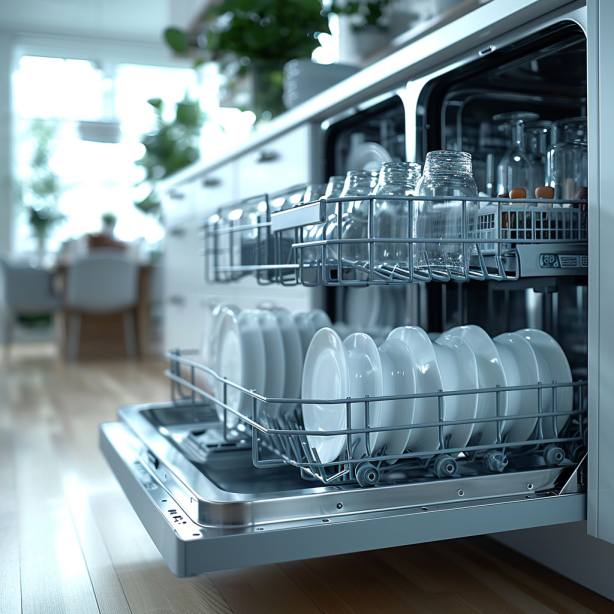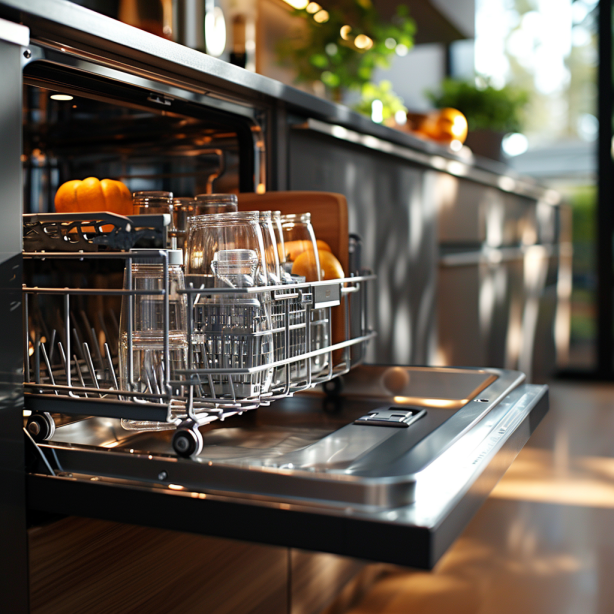
According to cleaning experts, it’s important to clean dishwasher racks…
….regularly to prevent buildup of food and grime, which can lead to clogged spray arms, mold growth, and bad odors.
Racks should be cleaned once a month or when buildup is noticed.
All it takes is some hot water, dish soap, a toothbrush, and a little elbow grease to scrub the racks clean.
Keep reading this short guide to learn the simple process for…
… how to clean dishwasher racks and keep them sparkling.
KEY TAKEAWAY
How to clean dishwasher racks?
- Cleaning dishwasher racks involves a systematic process, from removal to deodorizing, ensuring optimal hygiene and performance. (1)
- Regular maintenance, using simple steps and common household items, guarantees a sparkling clean and efficient dishwasher rack.
Remove Racks and Assess Condition
The first step is to remove all the racks from your dishwasher so you can thoroughly clean them.
Carefully pull out the top and bottom racks then set them aside.
Now take a close look inside the dishwasher.
Check nooks and crannies for any food particles or debris left behind.
It’s also a good idea to inspect the racks themselves.
Over time, hard water or mineral buildup can cause grime or rust spots that need attention.
Make notes of any problem areas you’ll focus on during cleaning.
Cleaning Methods
Scrubbing
This is my favorite way to clean dirty racks and the inside of the dishwasher.
Simply mix up a bowl of hot, soapy water using your favorite dish soap.
For tough messes, add a squirt of white vinegar which acts as a natural degreaser.
Dip your brush in the solution and scrub away stuck on gunk in problem zones.
Target any buildup around spray arms and the door seal track.
The vinegar cuts through food residues while the soap lifts crud.
Be sure to scrub both sides of each rack as well.
Rinse thoroughly with clean water when you’re done to remove any leftover cleaner or grime.
A rinse aid will help prevent new mineral deposits from forming too.
Cleaning your dishwasher regularly is key to keeping it performing at its peak.
Whether you’re dealing with hard water stains from your area or just general food particles, a deep clean every few months is recommended.
Baking soda is another kitchen staple that works great for absorbing odors and light scrubs.
Just sprinkle some onto a damp rag or brush and wipe down surfaces.
Its natural abrasiveness lifts stuck on messes without chemicals.
Always empty the dishwasher before cleaning and pay special attention to the tracks where food likes to collect.
With simple steps like these, your dishwasher will stay sparkling for years to come!
Dishwasher Cycle

Running the dishwasher through a hot cycle with just racks inside is a simple way to deep clean them. (2)
Follow these easy steps:
- Step 1: Remove all other dishes and place just the racks in the empty dishwasher.
- Step 2: Run the hottest water temperature cycle your dishwasher offers and add a normal amount of dishwasher DETERGENT to help cut through caked-on gunk.
- Step 3: Once the cycle is complete, leave the racks inside to fully AIR DRY before replacing them in the dishwasher. This helps prevent any potential mold or mildew growth.
Vinegar Soak
For really stubborn spots, try soaking racks in a vinegar-water solution. Vinegar is a natural disinfectant and degreaser that can help break down built up SPORE AND FOOD DEBRIS.
- Step 1: Mix equal parts WARM WATER and white distilled VINEGAR in a large tub or sink.
- Step 2: Fully submerge racks in the solution and let soak for 30 minutes or longer if needed. The acetic acid in the vinegar will work its magic on any caked-on grime.
- Step 3: After soaking, gently SCRUB any remaining spots with a soft brush or cloth. RINSE thoroughly to remove any vinegar residue before replacing racks in the dishwasher.
Baking Soda Paste
Making a paste out of good ol’ baking soda is one of the easiest and most effective ways to clean stubborn buildup off oven racks.
Just follow these simple steps:
- Step 1: Make a paste by mixing baking soda with just enough water to form a spreadable consistency. The baking soda will act as a gentle abrasive while the water helps it stick to surfaces.
- Step 2: Generously apply the baking soda paste to coat all sides of oven racks, especially where you see caked-on grease or burnt-on food bits. No need to rinse first.
- Step 3: Let the paste sit on the racks for at least 30 mins before scrubbing off with a damp cloth or non-abrasive scrub brush. The longer you let it sit, the better it can work at cutting through tough grime. Rinse thoroughly and dry completely before putting racks back in the oven.
Maintenance

To help prevent buildup from becoming so stubborn in the first place, clean any visible messes off racks as soon as possible after use.
Wiping them down with a paper towel while they’re still warm makes messes much easier to handle.
I also like to give my racks a quick spray with an all-purpose cleaner or…
…stainless steel polish and wipe down periodically to keep them shiny and protected.
You can tell it’s time to replace oven racks when they have…
… deep scratches, heavy pitting, or badly warped frames that no longer allow for even baking.
Racks are a pretty affordable replacement item, usually $20-40 for a basic set.
Be sure to adjust your oven racks to the recommended height positions noted in recipes to allow for optimal air flow and consistent cooking results.
Frequently Asked Questions
How do I clean my dishwasher door?
The dishwasher door is prone to collecting soap scum and mildew over time.
To clean it, wipe it down with a damp microfiber cloth or rag dipped in warm water.
For tougher builds up, mix a spray of warm water and white vinegar and spray it on problem areas, wiping clean with the damp cloth.
How do I clean the dishwasher filter?
It’s important to clean the dishwasher filter regularly to keep your dishwasher running efficiently.
Remove the filter, which is usually located at the bottom of the dishwasher, and rinse it under warm running water.
Soak any stuck-on food bits in a cup of white vinegar to help dissolve them.
How do I clean the inside of my dishwasher?
To deep clean the inside of your dishwasher, start by removing all racks and utensil holders.
Wipe down the walls and door with vinegar and baking soda spray or a stainless steel appliance cleaner and damp cloth.
Pay special attention to the spray arm jets where food and soap scum collect.
Rinse all cleaning supplies off before running an empty hot cycle.
How do I clean the dishwasher racks and utensil holders?
The racks and utensil holders often collect mold and mildew in hard to reach areas.
Remove them from the dishwasher and fill the bottom with a cup of white vinegar.
Let them soak for an hour before scrubbing with a damp cloth or soft bristle brush.
Rinse thoroughly and allow to air dry completely before returning to the dishwasher.
How do I keep my dishwasher clean between uses?
To keep odors and residues from building up between uses, leave the dishwasher door open…
… after a cycle finishes to allow it to air out fully.
Wipe down any visible food particles or residues…
… on the door seal, racks, and interior with a warm damp cloth.
How often should I clean my dishwasher filter?
It’s recommended to clean the dishwasher filter every month or so to prevent clogs.
Look for debris and food particles trapped in the filter and rinse thoroughly with warm water.
Let it air dry completely before replacing.
A clean filter helps improve water circulation for superior cleaning power.
Will vinegar damage my dishwasher?
Using white vinegar in your dishwasher as a cleaning agent is generally safe…
… for most models as long as you avoid mixing it with harsh chemical cleaners.
Stick to a cup or less of vinegar in the detergent dispenser…
… on the hottest cycle to help dissolve soap scum and odors without damaging interior components over time.
Avoid undiluted vinegar.
Conclusion
Keeping dishwasher racks clean should be part of your regular kitchen cleaning routine.
Grime not only looks unsightly but can lead to spots on dishes or mold risks.
Getting into a monthly habit of inspecting for debris, wiping racks down, and running empty dishwasher cycles pays off.
For tackling stuck-on messes, let hot water and cleaning agents like dish soap, vinegar, and baking soda soak in first before scrubbing.
Repeating cycles or soaking for extremely dirty racks may be needed.
Adjusting rack positions can also help target cleaning.
Staying on top of minor upkeep prevents having to deep clean racks quite so often.
But when grime does build up, use the effective scrubbing, Dishwasher cycle, vinegar soak, and baking soda paste methods outlined here.
With some elbow grease, your racks will once again come out sparkling clean.
What other tips do you have in mind? Please comment below!
References
- https://www.nytimes.com/wirecutter/reviews/how-to-clean-dishwasher-of-mold/
- https://home.howstuffworks.com/home-improvement/household-hints-tips/cleaning-organizing/how-to-clean-a-dishwasher.htm#:~:text=the%20image%20above.-,Run%20a%20Vinegar%20Cycle,with%20hottest%20water%20setting%20possible.
Related Articles
- https://milkwoodrestaurant.com/how-to-clean-plastic-dish-rack/
- https://milkwoodrestaurant.com/how-to-clean-rust-off-metal-dish-rack/
- https://milkwoodrestaurant.com/can-you-put-a-dish-rack-in-the-dishwasher/
Was this helpful?

I’m Mary R. Q. , a seasoned professional chef dedicated to elevating home cooking experiences. Through my expertise in the culinary arts, I provide practical cooking tips and insightful reviews of kitchen utensils on my blog, milkwoodrestaurant.com. As a passionate advocate for transforming everyday meals into extraordinary culinary adventures, I aim to empower home cooks with the knowledge and tools they need to create delicious and memorable dishes. I’m also an author of the book “1,001 Kitchen Tips & Tricks: Helpful Hints for Cooking, Baking, and Cleaning (1,001 Tips & Tricks)” which is sold on Amazon. Join me on a flavorful journey as we explore the art of cooking and the essential tools that make it a joy.










